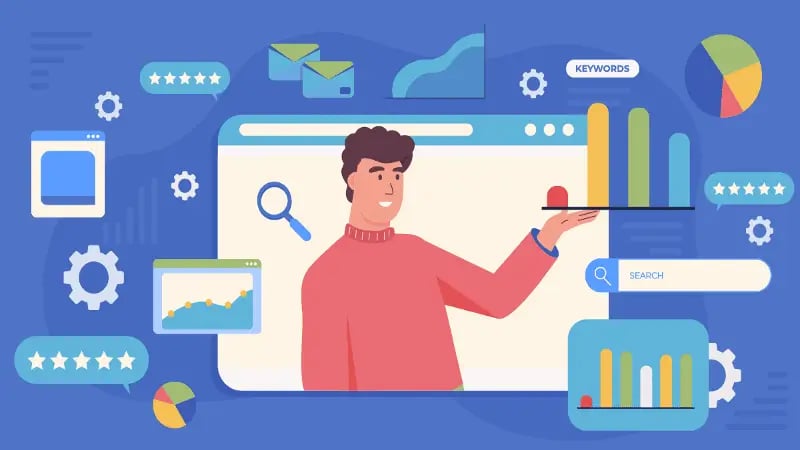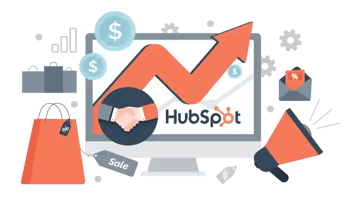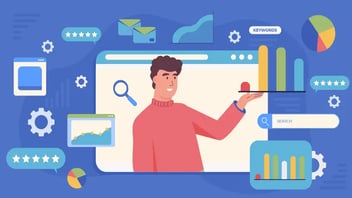The History of Sales Enablement and Why It's Here to Stay
Sales enablement is a powerful tool that equips your salesforce with the resources, knowledge, and processes they need to consistently convert leads into customers. But where did this concept originate, and how has it evolved over time?
This blog post delves into the history of sales enablement, highlighting key milestones and showcasing its enduring relevance in today's dynamic sales landscape.

The History of Sales Enablement
The Seeds of Sales Enablement: Pre-1980s
The roots of sales enablement stretch back far beyond the digital age. The concept of equipping salespeople with the tools and knowledge to succeed is deeply ingrained in human history.
Even in the ancient world, the art of persuasion was highly valued. Greek and Roman societies placed immense importance on rhetoric and oratory, skills essential for effective salesmanship. These early civilizations laid the groundwork for understanding the power of communication in driving sales success.
Fast forward to the Industrial Revolution, a period marked by rapid technological advancements and mass production. As businesses scaled, the need for standardized sales processes became apparent. To ensure consistency and efficiency, companies began developing formal training programs to educate salespeople about product features, benefits, and sales techniques. While rudimentary by today's standards, these early training initiatives represented the first steps towards structured sales enablement.
To complement these training efforts, businesses recognized the value of providing salespeople with tangible materials to support their efforts. Sales brochures, pamphlets, and product catalogs emerged as essential tools, offering concise product information and key selling points. These content materials served as early forms of sales collateral, helping salespeople effectively communicate with potential customers.
While these early practices may seem primitive compared to modern sales enablement strategies, they established fundamental principles that continue to shape the industry today. The emphasis on training, equipping salespeople with knowledge, and providing supporting materials laid the foundation for the sophisticated sales enablement solutions used by businesses worldwide.
The Dawn of Modern Sales Enablement: 1980s-1990s
The 1980s marked a pivotal era in the evolution of sales enablement as technological advancements began to reshape the sales landscape. The advent of personal computers and the subsequent rise of the internet revolutionized how information was created, accessed, and shared. This digital transformation laid the groundwork for modern sales enablement practices.
As businesses sought more efficient ways to manage customer interactions and sales processes, early customer relationship management (CRM) systems emerged. These pioneering software solutions provided a foundation for tracking customer data, managing sales pipelines, and improving overall sales productivity. While rudimentary compared to today's robust CRM platforms, these early systems represented a significant step forward in sales automation and efficiency.
In parallel with these technological developments, content marketing began to take root. Recognizing the need to educate and inform potential buyers, companies started producing more sophisticated marketing materials. White papers, case studies, and customer testimonials emerged as valuable tools for establishing thought leadership and building trust. These resources empowered salespeople with compelling content to share with prospects, strengthening their sales pitches and increasing the likelihood of closing deals.
The 1980s and 1990s laid the groundwork for the sales enablement practices we know today. The convergence of technology, CRM systems, and content marketing created a fertile environment for the growth and development of more sophisticated sales enablement strategies in the decades to come.
Key Milestones
-
1986: SalesLoft, a pioneer in sales engagement technology, is founded.
-
1987: Tom Siebel, the "Father of CRM," founded Siebel Systems, a leading CRM software company.
-
1990: Content marketing became a strategic focus for many companies, with the rise of content management systems (CMS) making content creation and distribution easier.
The Evolution of Sales Enablement: 2000s-Today
The 2000s ushered in a new era of sales enablement, characterized by rapid technological advancements and a shift in customer expectations. The rise of social media platforms like LinkedIn and Twitter transformed the way businesses interacted with customers. Salespeople embraced social selling, leveraging these platforms to build relationships, establish thought leadership, and generate leads. Social media empowered salespeople to connect with potential customers on a more personal level, fostering trust and engagement.
As data became increasingly accessible and valuable, sales enablement took on a more data-driven approach. Companies began harnessing customer data and sales performance analytics to gain deeper insights into buyer behavior and sales effectiveness. This data-driven approach enabled sales teams to identify trends, optimize sales processes, and personalize the customer experience. By leveraging analytics, businesses could make informed decisions, improve sales forecasting, and allocate resources efficiently.
To streamline sales operations and provide salespeople with easy access to essential resources, dedicated sales enablement platforms emerged. These platforms offered a centralized hub for managing sales content, training materials, and sales tools. By consolidating these resources in one location, sales enablement platforms enhanced efficiency, improved sales productivity, and ensured consistent messaging across the organization. As sales teams became more mobile, these platforms also enabled salespeople to access critical information and tools on the go, empowering them to be more effective in the field.
Key Milestones
-
2003: LinkedIn launches, becoming a major platform for professional networking and social selling.
-
2008: The term "sales enablement" gains widespread adoption within the sales industry.
-
2010: Sales enablement platforms like Allego, Showpad, and Seismic experience rapid growth.
Why Sales Enablement is Here to Stay
Sales enablement is no longer a luxury but a necessity. By equipping your sales team with the right resources, knowledge, and processes, you empower them to consistently exceed expectations and drive business growth.
The impact of sales enablement on business performance is undeniable:
-
Increased Win Rates: Companies that have robust sales enablement practices often see a substantial uplift in their win rates. Research indicates that these organizations can experience a win rate increase of between 5% and 10%. This translates directly to more closed deals and higher revenue.
-
Boosted Sales Productivity: Providing salespeople with the right content and tools at the right time is a game-changer. Salespeople who have ready access to relevant information can experience a productivity boost of up to 20%. This means more efficient deal cycles and increased sales output.
-
Accelerated Sales Cycles: Effective sales enablement streamlines the sales process, leading to shorter sales cycles. Organizations with formal sales enablement programs can reduce their sales cycle by an average of 7%. This translates to faster time-to-revenue and improved cash flow.
Effective sales enablement is not just about providing tools; it's about creating a culture of continuous learning and improvement. By investing in sales enablement, you're investing in the long-term success of your organization.
As the sales landscape continues to evolve, so too will the role of sales enablement. By staying ahead of industry trends and adapting to changing customer needs, you can ensure that your sales team is always equipped to thrive.
The Future of Sales Enablement: Embracing Continuous Innovation
The Rise of AI
The future of sales enablement is undeniably bright, driven by technological advancements and evolving customer expectations. Artificial intelligence (AI) is poised to revolutionize the sales landscape with its potential to automate routine tasks, provide real-time coaching, and deliver highly personalized content recommendations. AI-powered tools will augment salespeople's capabilities, enabling them to focus on building relationships and closing deals.
The Era of Customer Centricity
Customer-centricity will remain a paramount focus as sales enablement continues to evolve. As customer expectations rise, sales teams will need to be equipped with the tools and knowledge to deliver exceptional experiences at every touchpoint. Sales enablement will play a crucial role in aligning sales and marketing efforts to create a seamless customer journey, fostering loyalty, and driving long-term growth.
The Importance of Agility and Adaptability
To thrive in this dynamic environment, organizations must prioritize agility and adaptability. The sales landscape is constantly changing, with new technologies, customer preferences, and competitive pressures emerging. Sales enablement strategies must be flexible and responsive to these shifts. By staying informed about industry trends and customer needs, businesses can continuously optimize their sales enablement programs to drive success.
Successful sales enablement in the future will require a combination of human ingenuity and technological innovation. By embracing AI, prioritizing customer experience, and fostering a culture of agility, organizations can position themselves for long-term growth and competitive advantage.
Sales Enablement: A Cornerstone of Sales Success
The journey of sales enablement is a testament to the evolving relationship between technology, human interaction, and business success. From its ancient roots in persuasion to the AI-driven strategies of today, sales enablement has proven its enduring relevance. By understanding its history and embracing its future, organizations can unlock the full potential of their sales teams.
Are you ready to transform your sales team into a high-performing revenue engine? Contact Aspiration Marketing today to learn how our expert solutions can elevate your sales enablement strategy. Let's create a future where your sales team consistently exceeds expectations.
This content is also available in:
- German: Die Geschichte des Sales Enablement und warum es sich durchsetzen wird
- Spanish: La historia de la capacitación en ventas y por qué está para quedarse
- French: L'histoire de l'activation des ventes et les raisons de sa pérennité
- Italian: La storia dell'abilitazione alle vendite e il motivo per cui resterà
- Romanian: Istoria sales enablement și de ce este aici pentru a rămâne
- Chinese: 销售促进的历史及其长盛不衰的原因

Joachim is a certified HubSpot trainer with over 13 years of experience in content marketing, strategy, website development, and SEO. He has implemented numerous large-scale, international growth marketing programs, including one with UiPath, which grew from a startup to a successful IPO on the NYSE. Joachim has special expertise in multilingual marketing and sales enablement projects, and he uses the latest AI technologies to help our clients.








Leave a Comment